
Castlevania Dawn of Sorrow is something rare in the Castlevania series. It is a direct sequel to another Castlevania game,
Castlevania: Aria of Sorrow. Every Castlevania game is connected to the overall story, unless they have been erased from canon, like
Castlevania Legends, but rarely do we get a direct continuation of a single story. The game was released on October 4th 2005, two years after Aria of Sorrow, and follows the story of Soma Cruz and his friends from the last game. Not only is the story a continuation, but so is the gameplay. It takes the elements established in Aria of Sorrow and refines them into a more complex game. Do these gameplay refinements translate into a better game? You’ll have to read on to find out.
StoryNote: This review contains spoilers from Aria of Sorrow and some from Dawn of Sorrow, throughout.Dawn of Sorrow takes place one year after the end of Aria of Sorrow. Soma has gone a year without being able to use his powers. Since his last adventure, he has led a quiet life, studying and hanging out with his friend Mina. One day, they are walking around in the city when they are surprised by the sorceress Celia Fortner, leader of a new evil cult. Celia summons some monsters to attack Soma while Arikado conveniently appears to give Soma a weapon before being blocked off by a magical barrier. Soma attacks the monsters and absorbs their souls. After Celia disappears, Arikado tells him that he never lost the Power of Dominance, he just never had a need to use it. Soma then goes back to Castlevania to track down Celia and her henchmen in order to stop them from executing their evil plans. Little does he know, this is exactly what Celia wanted. The narrative once again brings Soma to Castlevania and reunites him with his old friends Genya Arikado, Julius Belmont, Yoko Belnades, and Hammer. While the story is not as original as the one in Aria of Sorrow, it is still interesting. However, just like in Aria of Sorrow, I am disappointed from
Death lack of involvement, other than being a boss.
 Seriously people. Can’t you give the poor couple some privacy?Graphics
Seriously people. Can’t you give the poor couple some privacy?GraphicsThe graphics in this game are excellent. They are a big step up from the previous GBA efforts. They are so good in fact, I’d go as far as saying they are superior to those in Symphony of the Night. Characters are large and well animated. The castle is colorful or somber, depending on which areas you are visiting. They are not distractingly colorful though, like in HOD. Some backgrounds are filled with beautiful effects such as the snow in the abandoned village. Other backgrounds are completely done in 3D, something new for the series. As you walk forward or backward, these backgrounds move as if you were looking at them from different angles. It’s a very cool effect on an otherwise 2D game.
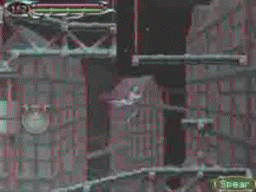 Look closely at the background and you will notice that the view of the buildings changes as you move.
Look closely at the background and you will notice that the view of the buildings changes as you move.Enemies are also very detailed. In this game most enemies are large and bosses are even bigger. They are also nicely animated and provide the game with some pretty cool graphical effects. For example, there is a boss late in the game called
Aguni that generates heat inside the room. The boss itself looks impressive and the effect of the heat wave as you fight is really atmospheric as you can see in the video below. The last boss in the game,
Menace, is also very impressive. He starts off fighting you
as part of a room, like
Chaos from Aria of Sorrow. After you defeat this form, he will suddenly
stand up to an impressive size of hundreds of feet . Game wise, he’s about
four screens tall.
Kojima and company have also decided to give Soma his own shadow trail. If you remember from my review of Aria of Sorrow, I complained that Juste was given a shadow trail in HOD for some reason, while Soma does not have one in AOS. I argued that it is more logical for him to have one than Juste, given his status as Dracula’s reincarnation. Whether due to being unhappy with Juste’s trail or graphical limitations, Soma didn’t have a shadow trail in AOS. However, he finally gets one in DOS. It’s more subdued than Alucard’s in SOTN, but it looks very cool.
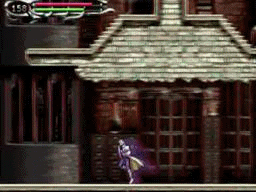 A subtle but effective use of the shadow trail.
A subtle but effective use of the shadow trail.The one downside to the graphics is that the character portraits were redone in anime style. Most everyone looks acceptable and it brings out emotions better, but Soma really suffered from the transition. His hair looked good in Aria of Sorrow, here he looks like an unkempt dog. It also makes the game look a little goofy.
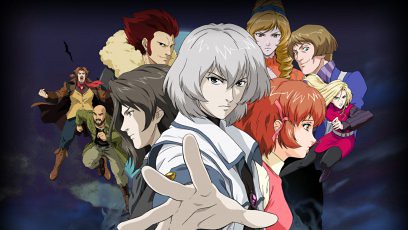 Don’t miss Castlevania: Dawn of Sorrow, Saturday mornings, right after Yu-Gi-Oh.Sound
Don’t miss Castlevania: Dawn of Sorrow, Saturday mornings, right after Yu-Gi-Oh.SoundJust like the graphics, the sound and music in Dawn of Sorrow are better in than those in Aria of Sorrow. There are a lot more voice samples from the characters and the enemies (still in Japanese) and all the other sounds effects are also top notch. The music is, just like in AOS, exquisite. Some tracks are forgettable, such as the
Wizardry Lab and the
Abyss, but most are excellent. My favorite tracks are the
Pitch Black Intrusion,
The Beginning and
Bloody Tears from Julius Mode, and the
Final Fight with
Soma in Julius Mode, which is a remix of
Dracula’s Theme from Rondo of Blood. It is an amazing remix made even more powerful by
Soma’s creepy laugh. It just sets the mood for an epic encounter.
GameplayThe Gameplay in DOS is amazing. It is a refined version of the gameplay from AOS with some new tweaks which actually make the game better. It still follows the Metroidvania type of gameplay and Soma still controls as tightly and smoothly as he did in AOS, except for when you
turn into a bat; there’s a slight lag that wasn’t there in AOS, but it’s still better than performing the same action in SOTN. New to the game are strong attacks. Just press “a” and Soma will use his current weapon to perform a strong attack which uses some MP. Just like in AOS, the equipment is divided into weapons, armor, and accessories and Hammer acts as the game’s shopkeeper. The game is easy at first but gets progressively harder. You will actually have to grind a lot more in this game than in AOS, but still not as much as in COTM.
DOS also has some touchscreen elements added to the gameplay, but they feel a little bit tacked on. There are some ice crystals throught the game that you will have to destroy after you get the appropriate soul. You destroy them by tapping them on the touchscreen. This really adds nothing to the game except for the annoyance of having to touch the screen at inopportune moments.
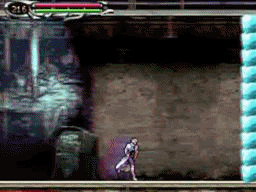 An example of a superfluous use of the touchscreen.
An example of a superfluous use of the touchscreen. There’s also a new seal system in which bosses need to be sealed by scribing symbols on the screen after the bosses are defeated. The seals become progressively complex as you deal with harder bosses. They are also needed to enter boss rooms. The seals are scattered throughout the castle and you have to find them if you want to progress. The idea is interesting, but the execution is annoying. After the seal appears at the end of the boss fight, you have little time to trace the seal. You’ll either have to have your stylus in your hand or on your lips (as I do) or trace the seal with your nails. Also, if you fail to seal the monster, he will regain some HP and continue fighting until you seal it.
Since DOS is a direct sequel to AOS, you’d expect the Tactical Soul System to make a return. And you’d be right. The system makes a triumphant return, with upgrades to boot. Let me explain the basic system first, then I’ll get to the upgrades. The Soul types are exactly the same from the last game, so I’ll just rehash the explanation from my AOS review.
Guardian Souls: these provide mainly defensive abilities such as summoning Familiars, temporary invulnerability, or shapeshifting. They are activated or toggled with the R button.
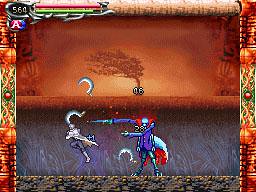
Death
Bullet Souls: these provide subweapon-like functionality such as fireballs and other attacks. They are activated with the UP+B button combination.
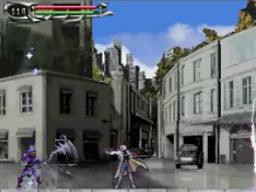
Skeleton
Enchanted Souls: these work to give Soma new latent abilities such as walking on water or increasing statistics.

Golem
Ability Souls: these provide always-on abilities such as a double-jump and slide move. These are generally obtained from bosses and used to mediate level design in the same manner as in the Metroid games; that is, as new abilities are acquired, more areas are available to the player to explore.
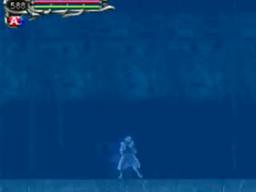
Rahab
However, obtaining a soul is not as easy as killing an enemy. Each enemy has a soul drop rate. So for example, if one enemy has a drop rate of 1/100 it means that every enemy of that type you kill has a 1/100 chance of giving you a soul, not that you will get a its soul after defeating 100 of them. So you may defeat 200 Peeping eyes and still have no luck. Soul drop rate is also dependent on luck. The higher your luck stat, the easier it will be to obtain souls.
There are some new elements to the TSS. First, the more souls you obtain the more powerful certain souls become. For example, if you collect the maximum of 9 Skeleton Souls, the bones that you throw become bigger and more powerful.
There’s also a new weapon’s upgrade system which uses souls as currency. The game’s best weapons can only be obtained by using this upgrade system. In order to gain them, you will have to give up some of your souls. This is not a big problem unless you need to use boss souls, which can only be found once in the game. In order to get back those souls, you’ll have to replay the game again in New Game+ mode.
Finally, there is also a special soul called the Doppelganger. After you obtain it you’ll be able to switch between two sets of weapons/souls. This soul is extremely useful and makes the game more streamlined since you can set different sets of weapon/soul combinations and just press the Y button to switch between them.
Dawn of Sorrow is a longer game than AOS. I finished the normal game in 15:00 (hr:min) compared to Arias’s 11:34. After that, I played it in Hard Mode and finished it in 3:34 compared to Aria’s 1:54 (you can carry over souls and weapons) and then Julius Mode in 3:23 compared to Aria’s 1:36. I played around 30 minutes with the Boss Rush Mode and my best time is 5:30 (min:sec). Total time: approximately 22:27 hours compared to Aria’s 14:30 hours. As you can see, the game will take you significantly longer to finish than Aria of Sorrow.
ExtrasBoss Rush: can be unlocked by beating the game with the best ending. You can use your save file and take any experience, souls, weapons, armor, and accessories you have into battle. The recovery items you can use are fixed, though. You fight 13 bosses in succession and you can get different items depending on your time. These items can only be obtained through this mode and they are added to your save file. You can also play as Julius in this mode.
Hard Mode: In Hard Mode, enemy stats are increased making the game harder. There are also some items and one soul that can only be acquired in Hard Mode. In order to obtain the Hard Mode beat the game with the best ending (beat Menace), after that, you can choose to start a New Game + on that file on either Normal or Hard difficulties.
Sound Test: You can access a sound test after you get the best ending.
New Game+: You can access the New Game+ mode after you get the best ending. You will be able to take all equipment, items, and most souls into this new game.
3 endings:
Worst Ending: During the second battle with Dario, simply beat him.
Bad EndingDuring the second battle with Dario, use the Paranoia soul to enter the mirror. After you beat the new boss, Aguni, go back to the other side of the mirror and get the magic seal. Go to the center of the castle and enter the boss door without Mina’s Talisman equipped.
Best Ending Use the Paranoia soul to fight Aguni, pick up the magic seal, and go back to the center of the castle. When you enter the boss door have Mina’s Talisman equipped. You will now get a more extended version of the game and all you have to do is beat it.
Julius Mode: This has got to be one of the coolest unlockables ever. Julius mode is the same unlockable mode from Aria of Sorrow, after a steroid injection. It also has a little bit of story. Basically, it’s a continuation of the Bad Ending, where Soma has become Dracula and it is up to Julius Belmont to stop him. Along the way you recruit both Yoko and Alucard (Arikado’s real identity). In a homage to Castlevania III, you can switch between all three characters on the fly and use them however you deem appropriate.
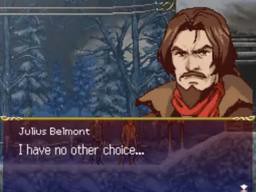
He has no other choice.
Each character has unique skills. Julius uses the Vampire Killer as his main weapon. You can also use it to destroy ice blocks with it. You can also use the following subweapons: cross, axe, potion, and cross item crash. Julius can triple jump, twice with the “b” button and once with the “L” button. He can also slide and Dash Backwards.

Julius
Yoko Belnades attacks with a staff. She has three magical attacks that can be switched with the R button: a Fire attack, an ice attack, and a lightning attack. She can double jump, slide, and somersault backwards. She can also regenerate MP at a faster rate than the other two. In addition, she can also regenerate HP by attacking foes with her staff.
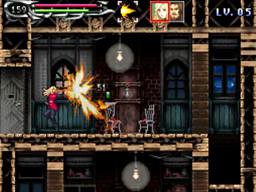
Yoko
Alucard looks exactly like he does in SOTN and he even has better animations than Soma. When he runs, he leaves a red shadow trail behind him. He can turn into a bat and shoot three fireballs, just like Dracula. He can double jump plus “hyppogryph jump” forever. His strong attack teleports him behind the enemy to strike twice. Unfortunately, he can’t slide.

Alucard
The game itself is a more involved version of the previous Julius mode. Besides being able to use more characters, you are now able to level up. There is no subscreen however; pressing start just pauses the game. Also, you can’t go into mirrors. All bosses are automatically sealed so you don’t have to go through the hassle of using the seal system every time you defeat one. The music in this mode is the same as the normal game except for a few choice retro pieces which I have already spoken about in the Sound section. It is very important to note that all three characters share the same HP and MP bars and you cannot buy anything in this mode, including recovery items. There are only two ways to recover your health. You can either save at a save spot or you can attack enemies with Yoko’s staff, which recovers a couples of hit points with each hit.
The game takes you all the way into the end of the Abyss. However, instead of fighting Menace you fight Soma-Dracula. To me, this is the coolest boss fight in the game. Not only do you get to finally fight Dracula, you can do it with all three characters. Also, depending on which character you enter his room with, you will get a different introductory speech to the fight.
Final Thoughts:Castlevania Dawn of Sorrow is a magnificent game. The graphics and sound are amazing and the gameplay is superior to any Castlevania game before it. It is also a deep game which will take more than one playthrough if you want to finish it completely. And that is without delving into the extras such as Boss Rush and Julius Mode (one of the coolest extras ever). Originality issues aside, this is one of my favorite Castlevania games ever. I highly recommend this game to everyone with a DS or 3DS.
Trivia:The Silenced Ruins area is a direct tribute to the first Akumajou Dracula/Castlevania game for the Famicom/NES—in addition to similar visual designs, especially the interesting idea of making its last room mimic the first corridor of the first Castlevania, the background music is a remix of the background music for the first stages of this title that started the series, "Vampire Killer." Also, the boss in this area, the Bat Company, is a reference to the original Castlevania, where the first boss was a giant bat. Mine of Judgment also houses a tribute to a past Castlevania game; in this case, Super Castlevania IV. Back in Super Castlevania IV, as the player traveled up to the keep, Slogra was the first of the four final bosses they would meet, followed by Gaibon on the next floor, and then by Death just before the keep. In Dawn of Sorrow, as the player travels down the mine, they encounter Slogra and Gaibon as minor (although numerous) enemies, followed by Death as the boss of the area. The mine also features a reappearance of the music track Basement Melody from Haunted Castle. Julius Mode is a large scale homage to Castlevania III: Dracula's Curse. The party members are Julius Belmont (descendant of Trevor Belmont), Yoko Belnades (descendant of Sypha Belnades), and Genya Arikado in his Alucard form. There is no character analogous to Grant DaNasty in this mode. However, an analysis of the game's ROM revealed unused dialogue that hinted that Hammer was once planned to be playable in this mode. In Julius Mode the background music of The Lost Village is changed to a remix of 'Beginning' from Castlevania III: Dracula's Curse. Also the background music of The Dark Chapel is changed to a remix of 'Bloody Tears' from Castlevania II: Simon's Quest. Castlevania: Dawn of Sorrow is one of several Nintendo DS games that feature a subtitle with the initials 'DS', for fairly obvious reasons. Others include Tenchu: Dark Secret and Resident Evil: Deadly Silence. Castlevania: Dawn of Sorrow contains three items, the Crown, the Bell, and the Konami Man, as homages to the original NES Castlevania. The Crown can be found by sitting on one of the chairs in one of the most eastern rooms of the Demon Guest House, the Bell can be found by using the Bat Spell and flying into one of the bells in the Dark Chapel, and the Konami Man is found by crouching on a platform surrounded by spikes in the Cursed Clock Tower. Each of these items has the description simply stating the number of "points" they are worth. They have no effect on gameplay (although they can be sold to Hammer) but interestingly enough, they can be collected in Julius Mode, whereas all other items (besides magic hearts) cannot be picked up. It is unknown what their effects are in Julius Mode.
URL to share (right click and copy) 


